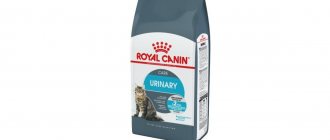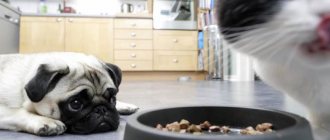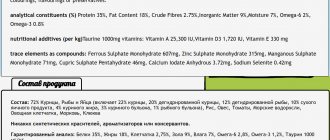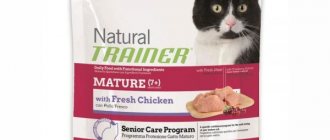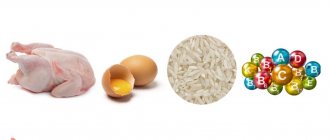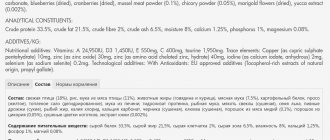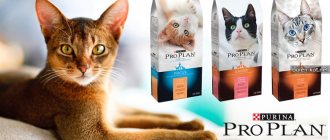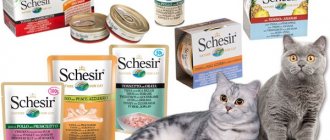How to tell if your cat needs to lose weight
In most cases, obesity develops gradually: if you see your pet every day, you may not notice changes in its appearance or behavior. The main signs indicating the need to lose excess weight include:
- Decreased pet activity. If your cat used to constantly play with a ball or jump on the highest cabinets and shelves, now he prefers to spend most of his time on the sofa or bed. Refusal from active play may be associated with joint pain or the development of shortness of breath, which occurs in an obese animal even with minor exertion.
- External changes. In healthy cats, bony protrusions (ribs, spine) can be easily felt and they have developed dense muscles. With obesity, the animal's waist flattens out, and a hanging belly and fat folds may appear. It is almost impossible to palpate bony landmarks.
- Increased appetite. If you previously fed your furry friend 3-4 times a day, then gradually the number of feedings increases. The animal greedily eats a portion of food and returns for more: there is no satiety due to a distended stomach.
Photo gallery: what obese cats look like
It is more difficult for an overweight cat to move around
Obesity causes sagging of the lower abdomen
Obesity is characterized by a flattened waist or its complete absence
The main factors for gaining excess weight in cats
In most cases, the cause of cat obesity is improper nutrition. The owner overfeeds the pet or adds too much fat and fast carbohydrates to the diet. However, there are other factors that influence excess weight gain:
- sedentary lifestyle: lazy cats are much more prone to obesity;
- castration or sterilization (changes in hormonal levels create the preconditions for gaining excess weight);
- stressful situations (change of residence, appearance of a new pet);
- pregnancy in a cat;
- availability of food in free access;
- abuse of treats;
- consequences of the operation (long-term immobility);
- diseases of the endocrine system requiring medication;
- belonging to some breeds (British cat, Scottish fold, Persian).
Video: veterinarian talks about obesity in animals
Feeding a cat with kidney disease natural food
Some owners note that despite treatment and specialized feeding, the pet’s condition worsens. Many veterinarians consider this fact to be a consequence of a neglectful attitude towards the animal’s food. Most often, owners make the following mistakes when feeding a cat with kidney pathology:
- Treating yourself to a harmful treat. Pity and great love for the pet lead to the fact that sometimes the owner treats him with his favorite product, which is excluded from the diet. In some cases, a slight deviation from the rules leads to irreversible consequences.
- Combination of natural food and prepared food. This combination can lead to an excess of unwanted microelements.
- Increase recommended servings. When the pet gets better, it develops an appetite. However, the animal’s diet is calculated in such a way that it receives the necessary nutrients without harming the kidneys. If the cat eats more, the load on the organ increases.
- Switching to normal food without veterinarian permission. Some owners give up the diet after they see an improvement in the cat's condition. However, with kidney failure, most often you have to adhere to a special diet for a long time or until the end of your pet’s life. Self-refusal to nutritional therapy can worsen the problem.
- Severe fluid restriction. With kidney failure, cats often experience frequent urination. Refusal to drink leads to dehydration and the development of urolithiasis.
How to organize food for overweight cats
When treating obesity in animals, veterinarians are guided by the same principles as nutritionists: the number of calories consumed should be less than their daily expenditure. Such a deficiency creates conditions for burning fatty tissue and allows the pet to quickly get into shape.
To achieve normal body weight, you can use both ready-made food and natural food (at the discretion of the owner).
Basic rules for creating a diet for obese cats:
- Monitor the quality of your food. Use only special food of at least premium class. The economy segment can cause additional health problems in cats. For the same reason, it is recommended to purchase only proven and fresh products when organizing natural nutrition.
- Provide access to clean water. Many cats with a fluid deficiency begin to eat more food to compensate for this deficiency. The water in the bowl should be changed at least twice a day to prevent dust, hair, and food debris from accumulating in it.
- The cat should be fed often, but in small portions. It is better to choose a specific time for this (8, 12, 16, 18, 22, 24 hours). And also stop any begging or food theft by the animal: treats also contain extra calories.
One of my friends’ cat gained a lot of weight over the winter: he gained about 4 extra pounds, which had a negative impact on his health. The owner decided to review his diet and strictly limited his food, and also regularly forced the cat to run after toys. For several months, she tried different types of food, but the furry pet’s weight stubbornly remained the same. The woman was about to seek help from a veterinarian, but one night she caught her husband in the kitchen, together with the cat, finishing a loaf of doctor’s sausage. Such nutrition negated all the daily efforts of the housewife. The husband was given a severe reprimand, and the furry purr was put on a strict diet, after which he still managed to get back into shape.
How to give?
Medicinal dry food for cats and dietary wet canned food, pates are prescribed by the doctor. For sick pets, feeding a special diet should be constant. Animals that have been diagnosed with a predisposition to diseases of the gastrointestinal tract, liver, and kidneys are allowed to mix dietary food with premium, holistic and super-premium food. It is not recommended to give antibiotic tablets to cats along with diet food, but herbal medicines will perfectly complement the diet. The feeding schedule and portion sizes are selected by the veterinarian; without any instructions, it is recommended to adhere to the norms indicated on the packaging.
Canned food for cats with digestive disorders and a tendency to food allergies is suitable for adult animals; it is better to give pates to kittens and elderly pets. Dry food must be washed down with water. For weakened and sick pets, special water is used for feeding cats, which can be purchased at a veterinary pharmacy along with food.
What ready-made food should you use to reduce your pet’s weight?
For the safe and slow treatment of obesity, a whole line of special veterinary foods has been developed. Unlike regular nutrition, they are aimed at eliminating excess weight and preventing further weight gain. The main advantages of using such feeds include:
- the ability to choose various flavorings;
- no time spent on cooking;
- long-term storage of feed;
- the effectiveness of such nutrition has been proven by veterinarians;
- the presence of the necessary components in the composition and a strict calculation of caloric content (in most cases, additional administration of vitamins and mineral components is not required);
- using a special feeder with timers to dispense a portion of a certain volume.
Mechanism of action and composition of dietary cat food
Medicinal food differs significantly from regular food. It contains much less fat and carbohydrates, which helps reduce the overall calorie intake. The mechanism of action of such food is to ensure longer saturation, stimulation of the gastrointestinal tract and normalization of metabolic processes in the cat’s body. This is achieved due to a certain balance of nutrients. The low-calorie food contains the following components:
- Plant fiber (beet pulp, bran, chopped oats, corn flour, brown rice, spinach). It acts as a natural scrub for the intestines, improving intestinal motility and stimulating timely bowel movements.
- Animal protein (processed beef, fish, poultry). Its amount is several times higher than the level of fats and carbohydrates, which allows you to burn excess fat without losing muscle mass.
- L-carnitine, taurine, mineral complexes and vitamins B, C, A, E. These components accelerate metabolic processes and restore the body’s need for various macro and microelements.
Is it possible to use diet food without consulting a specialist?
You should only select specialized food yourself if you have the appropriate education. When selecting a diet for obese cats, the doctor must take into account the breed of the animal, its weight, and the individual characteristics of the body. This allows you to determine the required calorie content, calculate the number of feedings and the volume of one serving. Before prescribing certain foods, blood tests should be taken to identify possible damage to the liver and digestive tract.
Contraindications to the prescription of dietary nutrition are pregnancy, lactation and age under one year.
How long should you feed your cat medicated food?
In order not to harm your pet’s health, it is necessary to reduce its body weight gradually (no more than 0.5–1% per week). On average, low-calorie food is prescribed for a period of 6 months to a year, after which the cat’s condition is monitored. In some cases (old age, upcoming surgery, certain breeds), the animal must adhere to such a diet throughout its life. This provides reliable prevention of further progression of obesity and increases life expectancy by several years.
It is also worth transitioning your cat to regular food gradually. One of my colleagues had a Persian cat who ate only dietary food for a year, which quenched his appetite and helped him stay in shape. The owner decided that the result had been achieved: the pet could be switched to its usual diet, after which it began to buy regular economy-class food. This diet is characterized by insufficient balance and a minimal amount of fiber. As a result, due to a lack of nutrients, the cat began to regularly steal food from the table, which caused stomach illness. The owners turned to the veterinarian, who selected the best food for them in terms of price and composition.
Is it possible to mix diet food with regular food?
Veterinarians do not recommend combining two foods with each other, since they have completely different energy values and composition. This leads to a significant decrease in the effect of dietary nutrition and the process of treating obesity slows down. But for many cats, a sudden change in diet can become very stressful: in this case, it is permissible to combine two foods with each other. Veterinarians recommend switching the animal to a new food within a week, gradually replacing the old one.
Changing food will be painless if the new food is introduced gradually
Prevention
Animal lovers are often confused when they discover that their cat has kidney failure. What to do in this situation? You need to treat your pet without wasting a minute and follow all the veterinarian’s recommendations.
But the disease is easier to prevent than to treat. To prevent kidney diseases, Royal Canin, Purina, Hill's, Brit Care, and Bosch Sanabelle have created special foods. Such food is available for sterilized and elderly cats. They are created taking into account the predisposition of such pets to kidney diseases.
But if your cat has problems urinating, blood in the urine, weight loss, or lack of appetite, you should get tested immediately. Start treatment in a timely manner. In such a situation, only medicated feeds are used, which are selected in accordance with the doctor’s recommendations.
The best food for cats with kidney failure is one that treats, helps pets with kidney failure live comfortably and prolongs their life.
Table: comparative characteristics of dietary feeds of various brands
| Name of food | Class | View | Flavors | Peculiarities | Price |
| Eukanuba Adult Sterilized Weight Control Chicken | Superpremium | Dry | Chicken | Designed for sterilized and neutered male cats |
|
| Hill's Prescription Diet Metabolic Weight Management | Superpremium | Dry | Chicken | Allows you to maintain optimal weight |
|
| Hill's Prescription Diet Metabolic + Urinary Weight Care | Superpremium | Dry | Chicken, turkey | Also used for cats with urinary tract diseases |
|
| Hill's Prescription Diet i/d Digestive Care (jelly) | Superpremium | Wet | Chicken | Helps maintain a healthy digestive tract |
|
| Hill's Prescription Diet w/d Digestive/Weight Management | Superpremium | Dry | Chicken | Helps normalize weight in diabetic cats |
|
| Hill's Prescription Diet w/d Digestive/Weight Management (jelly) | Superpremium | Wet | Chicken | Better absorbed by the pet's stomach |
|
| Royal Canin Satiety Weight Management SAT34 | Superpremium | Dry | Chicken, poultry | Can be used for diabetes and urolithiasis |
|
| Royal Canin Neutered Adult Maintenance | Superpremium | Wet | Chicken, pork, poultry, liver | Suitable for sterilized animals in the postoperative period |
|
| Pro Plan Veterinary Diets Feline OM Obesity (Overweight) Management dry | Premium | Dry | Chicken, poultry | Used for adult cats |
|
| Farmina Vet Life Natural Diet Cat Obesity | Premium | Dry | Chicken, pork, poultry | Prevents muscle loss | 2 kg - 1709 rub. |
| Royal Canin Satiety Weight Management (jelly) | Superpremium | Wet | Chicken | Suitable for pets with diabetes |
|
| Purina Pro Plan Veterinary Diets OM pouches | Superpremium | Wet | Chicken | Helps maintain weight |
|
| Happy Cat Adipositas | Superpremium | Dry | Chicken, poultry | Also used for cats with liver disease |
|
| Brit VDC Obesity | Superpremium | Dry | Chicken | Suitable for British cats, grain free | 2 kg - 1240 rub. |
| Forza10 Active Line | Superpremium | Dry | Fish | Consists of heart-shaped granules | 454 g - 470 rub. |
| Enova Breeder Cat Light Indoor | Superpremium | Dry | Chicken, rice | Can be used to feed cats over 7 years of age | 10 kg - 6300 rub. |
| Bosch Sanabelle Light for cats prone to obesity | Superpremium | Dry | Bird | Provides quick satiety due to the large amount of dietary fiber | 2 kg - 1300 rub. |
| Barking Heads Adult Fat Cat Slim | Holistic | Dry | Chicken, salmon | Suitable for pets with sensitive stomachs |
|
| 1st Choice Weight Control | Superpremium | Dry | Chicken | Designed for adult animals | 5.5 kg - 2600 rub. |
Photo gallery: examples of dietary foods
Hill's Prescription Diet i/d Digestive Care stimulates the stomach and intestines Purina Pro Plan Veterinary Diets OM pouches improves digestion Royal Canin Satiety Weight Management comes in jelly form Forza10 Active Line has an original heart-shaped granule shape Happy Cat Adipositas helps reduce weight in cats with disease liver Hill's Prescription Diet w/d Digestive/Weight Management is used for cats with diabetes Hill's Prescription Diet Metabolic Weight Management helps maintain proper body weight Pro Plan Veterinary Diets Feline OM Obesity allows you to quickly lose excess weight
Feeding Obese Cats Natural Products
If your animal has gained excess weight on a natural diet, you should also reconsider its diet. Don't forget that a healthy adult cat's diet should include proteins and fats of animal origin. You shouldn’t suddenly switch your furry pet to plant foods or greatly reduce portion sizes: this will only provoke unnecessary stress. Veterinarians recommend using the following products to feed overweight cats:
- Meat, offal and fish contain the required amount of protein and essential amino acids. Lean beef, rabbit, chicken or turkey are suitable for dietary nutrition. Of the by-products, preference should be given to hearts and liver. Meat should be served boiled or fresh frozen to destroy helminths. For dietary nutrition, steamed sea fish (trout, salmon) is mainly used.
- Milk based products. Kefir, cottage cheese, fermented baked milk, goat cheese, bifidok are sources of calcium and easily digestible protein, so they must be included in the cat’s diet. Please note that their fat content should not exceed 2–5%.
- Porridge and cereals. The fiber they contain provides satiety and acts as a natural scrub for the intestines, removing toxins. Cereals that are healthy for cats include rolled oats, brown rice, and millet. They need to be boiled in water or chicken broth.
- Greens and vegetables. They are used as an additive to cereals or meat: they should be boiled and ground in a blender. The best foods for feeding cats are spinach, celery, zucchini, squash, green beans, carrots, broccoli, and cauliflower.
Photo gallery: healthy foods for pets
By-products contain the required amount of protein
Dairy products are rich in calcium
Vegetables are the best source of vitamins and minerals
It is harmful to feed cats from the home table: our food contains a large amount of salt and various additives that negatively affect their health. Such a diet contributes to the development of obesity and other dangerous diseases. Veterinarians strictly prohibit giving overweight cats the following foods:
- sausage, frankfurters, small sausages;
- semi-finished products (cutlets, zrazy, dumplings);
- butter;
- chicken skin and fat from meat;
- bones;
- processed cheese;
- ice cream;
- sweet yoghurts and curds.
Diet for cats with kidney failure
A diet for kidney failure should only be prescribed by a doctor. Making your own menu for this disease is unacceptable. For your reference, below is an approximate daily diet:
- Breakfast. A tablespoon of boiled chopped buckwheat or oatmeal without milk, plus minced rabbit or beef - 8 g. Also add a little finely chopped lettuce or a small piece of grated boiled beets.
- Dinner. Boiled and pureed vegetables in the amount of 50 g. Add two tablespoons of minced meat and a teaspoon of porridge to them. The combination of porridge and minced meat is the same as for breakfast.
- Dinner. Boiled vermicelli (50 g), mashed with a fork. Add minced meat and broth (10 g) in which the minced meat was cooked.
- Before bedtime. A dessert spoon of noodles mixed with two spoons of baby meat food or a teaspoon of porridge mixed with the same amount of minced meat.
Once every seven days, the cat is given a little milk and three quail eggs. Twice a week, minced meat can be replaced with liver.
If the cat does not want to eat, then in case of kidney failure, veterinarians recommend force-feeding it from a syringe. It should be remembered that pets with kidney disease should not starve.
DETAILS: Acute kidney disease and chronic kidney disease in cats
Boiled chicken feet, chopped in a blender, are most suitable for syringe feeding. Infrequent introduction of children's cottage cheese "Agusha" or "Tema" and yogurt into the diet is allowed.
The diet for kidney failure is long-term. Due to the intake of a small amount of protein, there is a possibility of developing degeneration of tissues and organs. To prevent this from happening, veterinarians prescribe the drug “Ketosteril” in parallel.
Essential vitamins and mineral complexes
When organizing natural nutrition, it is quite difficult to take into account the cats’ need for vitamins and minerals when preparing a diet. Often, in their absence, metabolic processes slow down and various diseases can develop. To avoid such complications, you need to contact your veterinarian to select the optimal complex of vitamins and mineral components. They usually come in the form of pleasant-smelling tablets that can be crushed finely and added to your cat's food.
Give preference to proven products from a veterinary pharmacy. For example, adding crushed shells to an animal’s diet is not welcomed by veterinarians, as it can lead to digestive disorders.
The most popular vitamins and mineral complexes for cats:
- Beaphar Top 10 (contains taurine);
- Canina Cat-Vitamin Tabs;
- VetExpert VetAminex;
- Doctor Zoo "Health and Beauty";
- Dreamies pillows with chicken and taurine;
- Phytomines for castrated cats;
- Gimpet Schnurries (to normalize metabolism);
- Nutri-Vet Wild Alaskan Salmon Oil.
Please note that vitamins should be stored out of the reach of cats. Once, on the advice of a veterinarian, I bought vitamins for my cat, which he liked. I accidentally left the box on the table, which my pet took advantage of. He ate about half of the tablets, which did not affect his health in any way, but led to a complete aversion to them. The cat completely refused vitamins for several months.
Photo gallery: vitamins and mineral complexes
Canina Cat-Vitamin Tabs - multivitamin complex
Doctor Zoo is a domestic brand
Phytomines are used for castrated cats
Why is it important to properly feed a cat with kidney failure?
The kidneys are a paired organ that performs a number of important functions for the body. These include:
- formation and excretion of urine;
- elimination of nutrient breakdown products;
- regulation of body fluids and blood pressure;
- participation in the formation of certain hormones;
- maintaining blood composition and volume;
- normalization of metabolism;
- production of substances that promote calcium absorption.
Renal failure is a pathology that is expressed in impaired renal function. The disease can occur in cats as a result of past illnesses, improper feeding, poisoning, and congenital pathologies. Due to hormonal changes, aging and castrated animals are predisposed to the disease.
Renal failure can take acute and chronic forms (CRF). The acute course of the disease can be eliminated with timely measures taken. However, untimely therapy leads to the fact that the animal is forced to live with this problem.
With kidney failure, a cat's kidneys are unable to produce adequate urine output, eliminate toxins, and maintain normal hormonal levels. Gradually, the animal’s body is poisoned from the inside, which leads to disruption of the functioning of all internal organs and systems.
Complications that arise from the disease:
- heart pathologies;
- dysfunction of the gastrointestinal tract;
- hair loss;
- anemia;
- absence or frequent urination;
- softening of bones;
- disturbance of consciousness;
- convulsions;
- coma.
A special diet is aimed at reducing the load on the kidneys, accelerating metabolism and providing the body with necessary vitamins and microelements. A proper diet will reduce the risk of developing complications in chronic renal failure and speed up the process of therapy at the acute stage. Cats that follow a special diet remain active.

